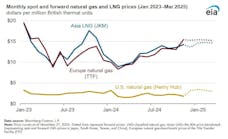Ending crude export ban would help rural US areas, House panel told
Rural US communities generally have benefited from the nation’s crude oil production renaissance, and potentially could be helped more if restrictions on exports of crude were eliminated, witnesses told a US House Agriculture Committee hearing on July 8.
Texas Railroad Commission Chairman David J. Porter called the crude export ban “a leftover relic from another period of time.” Allowing more US-produced oil to be sold overseas would spur domestic production, foster economic growth, and provide direct benefits to rural America and the nation as a whole, Porter said in his written testimony.
“The export ban is more than just an outdated policy,” he maintained. “Keeping it in place is actually harming our economy.” When crude prices recently dropped, Texas felt harsh economic impacts as thousands of production workers were laid off and rigs were idled, he told the committee. The number of drilling permits the commission issued fell from 2,389 in May 2014 to 916 in May of this year.
The ban also has created a discount for stranded US light, sweet crude over comparable grades overseas, Porter said. “This represents billions of dollars of lost revenue that could be pumped back into the US economy.”
The export ban is serving as a loophole for foreign producers to maintain their grip on US markets as abundant oil supplies are discovered, said Continental Resources Inc. Chief Executive Officer Harold Hamm. “Thanks to [the Organization of Petroleum Exporting Countries’] predatory pricing, more than 130,000 oil and gas workers have lost their jobs, and up to 500,000 jobs have been lost in supporting industries, since Thanksgiving,” he said in his written testimony.
Foreign entities own a third of US refining capacity, and nearly all of it is configured to process heavy crudes from Canada, Venezuela, Mexico, and Saudi Arabia, Hamm said. “We have been forced to discount our light, sweet oil into this limited domestic market—at times exceeding 20%—while the refiners sell their products at world prices,” he said. “As a result, refiner profits have soared 500% at no benefit to consumers or employment.”
Range of distortions
Another witness said the ban has created distortions in refining, including investment, by preventing crude production from sometimes reaching its most efficient processor, which could be outside the US; distortions in logistics, including investment, by causing excessive storage and transport; and distortions in production, including investment, because crude can’t be marketed to its highest value use.
“While the market for crude oil is globally integrated, the export ban segregates US crude from the world market, which punishes the US economy with price distortions,” CME Group Inc. Executive Chairman Brian A. Duffy said in his written testimony. “In order to encourage companies to invest in the production of crude oil here in the US, our domestic crude should be able to participate in the global free market for oil.”
The US oil and gas industry can rise to meet many challenges through innovation and hard work, but facing export restrictions at home places it at a serious competitive disadvantage, North Dakota Petroleum Council Vice-Pres. Kari R. Cutting told the committee.
US industry deserves the opportunity to compete globally, Cutting said in her written testimony. “Lifting the ban on crude oil exports would immediately restore its competitiveness and revive the renaissance in rural America,” she said. “Not only rural America would prosper, but all US citizens would benefit.”
Jamie Webster, a senior director at IHS where he leads the crude oil markets team, said in his written testimony that differences between unconventional and traditional crude production give the US potential to upend global markets.
“Conventional production projects can take years to finance, plan, and bring to the market,” Webster said. “US shale producers can do it in 4 months. “Globally, conventional production has a decline rate of 5-6%, meaning a project will be producing that much less each year. US shale production has an initial decline rate of about 50%. These two factors allow the US shale system to react quickly to market signals to bring more oil onto the market, and a lack of investment when prices turn downward can quickly reduce supply.”
Contact Nick Snow at [email protected].

Nick Snow
NICK SNOW covered oil and gas in Washington for more than 30 years. He worked in several capacities for The Oil Daily and was founding editor of Petroleum Finance Week before joining OGJ as its Washington correspondent in September 2005 and becoming its full-time Washington editor in October 2007. He retired from OGJ in January 2020.

